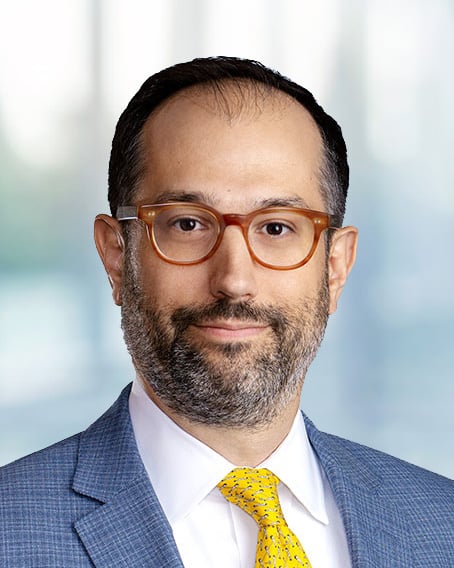In this next installment of our ETF podcast series, Ropes & Gray attorneys Brian McCabe, Jeremy Smith and Ed Baer discuss some of the issues facing non-ETF managers who are contemplating getting into the ETF space.
Transcript:
Ed Baer: Hello, and thank you for joining us today on this Ropes & Gray podcast. I'm Ed Baer, a counsel in the San Francisco office of Ropes & Gray. Joining me today are two of my colleagues from the asset management practice group, Brian McCabe, a partner in our Boston office, and Jeremy Smith, a partner in our New York office. In this podcast, which is part of a series of podcasts on ETF issues, we will discuss some of the issues facing non-ETF managers who are thinking about getting into the ETF space. First, let’s talk about the reasons an asset manager might want to get into the ETF business. Jeremy, can you tell us about some of the conversations you’re having with clients that are thinking about entering the ETF business?
Jeremy Smith: Sure. A big part of the appeal here is the product wrapper. Flows into ETFs have been strong for a number of years, with $500 billion being added last year alone. Investors have been drawn to ETFs by their relative tax efficiency, lower operating costs, the ability to trade shares intraday using flexible order types, and the availability of ETFs in adviser models. Adding to that, many managers are wrapper agnostic, meaning they are willing to deliver their portfolio management expertise to clients in whatever form works best for the clients. In addition to traditional mutual funds and separate accounts, managers are increasingly looking to offer their existing strategies in other vehicles, such as ETFs and collective investment trusts.
Brian McCabe: But as you mentioned, the ETF asset flow trends have been strong for years. Why are asset managers interested in ETFs now?
Jeremy Smith: Well, for starters, the ETF Rule was approved in 2019 and went into effect last year, and so the path to launching most ETFs has become a bit easier and less uncertain. And second, the SEC approved a number of semi-transparent ETF applications that permit actively-managed ETFs to operate without making their full holdings publicly available. These developments have prompted many new sponsors to explore entering the ETF market.
Brian McCabe: That makes sense. With reduced barriers to entry thanks to the ETF Rule and additional options for active managers to launch ETFs without sharing their ”secret sauce,” interest from traditional fund managers has been strong. With the advent of the ETF Rule, in 2020 we’ve seen a number of firms announce their intention to convert existing mutual funds to ETFs as a way for these sponsors to enter the ETF market with scale and a performance track record. We recently wrote a whitepaper about it. Jeremy, beyond precisely how to break into the ETF business, what are some of the first decisions a sponsor has to make when entering the ETF space?
Jeremy Smith: Well, some of the key early decisions include whether to rely on the ETF Rule to launch index-based or transparent actively-managed ETFs or to seek your own semi-transparent active ETF relief or license a third party’s relief, whether to establish a new board or to use an existing fund board to oversee the ETFs, and what distribution strategy to pursue.
Brian McCabe: How common is it for new sponsors to establish a separate board for their ETFs? I would imagine it would be efficient to make use of the same board for the ETFs and other registered funds. Another board would require additional board meetings, additional administrative and other resources to prepare materials and reports, and additional board and independent counsel fees.
Jeremy Smith: Yes, it depends in part on whether the manager plans to “go big” into ETFs. If the entre into ETFs will be significant, having a dedicated ETF board focused solely on supporting the ETF complex may make some sense, and this is the route that we’re seeing in a number of instances. But in our experience, most sponsors choose to enlist an existing fund board to oversee the ETFs for the practical considerations you noted, Brian.
Ed Baer: But it’s really something that sponsors should carefully consider. Arrayed against the efficiency and cost-effectiveness of adding ETF oversight to an existing board is the potential for conflicts that might arise if the same board is overseeing similar funds. In addition to having to worry about cannibalization of fund assets by the ETFs, differences in management fees may also present challenges. Not only do many ETFs utilize a unitary management fee out of which the adviser pays fund expenses, but the expense ratios of ETFs tend to be lower than those of comparable mutual funds. The board will have to understand the reasons for the differences in management fees and other expenses and, as fiduciaries to both types of funds, carefully assess the fee arrangements for the funds.
Brian McCabe: Agreed, although if a separate board oversees the ETFs, the manager will likely need to explain those reasons to both boards. Another key decision is what type of ETF to launch. The sponsor will have to decide whether to launch transparent index-based ETFs, or active ETFs or semi-transparent active ETFs. If they choose full transparency, the ETFs can rely on the ETF Rule, which provides certain advantages, including a smoother path to listing on an exchange, the ability to use custom baskets and significant asset class flexibility. In contrast, semi-transparent active ETFs seek to protect the ETFs from the risks of front running and free riding, but are currently able to invest only in exchange-traded instruments that trade contemporaneously with the ETF shares, like U.S. equities, certain futures contracts and options, and U.S. ETFs. Further, semi-transparent active ETFs may have only a limited ability to make use of custom baskets, and may need to seek a rule change under 19b-4 in order to list on an exchange. Filing a 19b-4 application introduces uncertainty into the ETF launch process, especially as to the launch timeline. Finally, going the semi-transparent active ETF route will require exemptive relief from the SEC, albeit on an accelerated timeframe, and potentially the payment of licensing fees to a third party.
Ed Baer: Jeremy, you mentioned the need to consider the distribution strategy for ETFs. Can you elaborate?
Jeremy Smith: Sure. To begin, ETFs aren’t necessarily sold in the same way as mutual funds. ETFs typically don’t charge 12b-1 or shareholder servicing fees, so intermediaries who sell ETF shares won’t receive those payments from the ETF. This partially explains why ETF expenses tend to be lower than comparable mutual funds. Instead, ETFs are often offered on certain platforms and as part of certain model portfolios, and the sponsors may pay platform or data fees for access to information regarding the users of their ETF.
Another less obvious consideration is how internal salespeople are compensated. Because ETFs are held in brokerage accounts and can be traded in the secondary market throughout the day, ETF sponsors don’t have the same access to information about who owns their shares from time to time. This makes it more difficult to understand who would be entitled to credit for sales of ETF shares than it is for mutual funds. For new ETF sponsors, it will be important to educate internal sales personnel on the ETF sales process and to align compensation arrangements to reflect the differences between ETFs and mutual funds.
Ed Baer: That’s a terrific insight. The internal education effort is something that’s easy to overlook in the scramble to bring your first ETFs to market. But that’s not the only key consideration. Sponsors have to recognize that ETFs are capital markets instruments, thus, it’s key for a sponsor to ensure that they have an experienced ETF capital markets person prior to launching ETFs. ETFs rely on experienced capital markets professionals to foster good relations with authorized participants (or APs) and market makers. The goal is to ensure that the ETF arbitrage mechanism is functioning effectively, and also that there is adequate liquidity and narrow bid-ask spreads for the ETF’s shares. In our experience, hiring an experienced ETF capital markets professional is key to the ETF launch effort. These professionals will typically have working relationships with the APs, market makers and exchanges, and will understand the interaction between the effective functioning of the arbitrage mechanism and the liquidity of the ETF’s shares.
Brian McCabe: That’s really interesting, but when you say, “ETFs are capital markets instruments,” what do you mean?
Ed Baer: Well, unlike mutual fund shares, ETF shares can be borrowed, loaned, sold short, margined and pledged. There’s a whole ecosystem of ETF borrowing and lending that facilitates asset hedging and shorting. There’s also an active options market for many ETFs, especially those with significant liquidity. Institutional investors sometimes create ETF shares in order to lend them out and earn extra income. At other times, APs and market makers will redeem shares to access the underlying securities to close out short positions or to adjust hedging positions.
Jeremy Smith: Focusing on the ways in which institutional investors make use of ETF shares for a moment, that’s exactly what we witnessed recently as part of the extraordinary movement in the value of Gamestop shares. Due to a sharp increase in the value of Gamestop shares, one ETF saw Gamestop shares come to represent over 20% of the ETF’s value. The ETF then saw 80% of its shares redeemed very quickly at a time that the ETF’s performance skyrocketed – again, largely due to the Gamestop position. It appears that APs redeemed shares of the ETF to obtain the hard-to-find Gamestop shares that could be sold to other investors, including, likely, short sellers desperate to close out their short positions in Gamestop. While this was a rather extraordinary situation, it illustrates the point that ETFs differ significantly from mutual funds and can be useful in the capital markets in ways that traditional mutual funds cannot.
Brian McCabe: Right, but this is far from the only difference between ETFs and mutual funds. For starters, the ETF Rule contains detailed conditions regarding basket construction, including complex rules governing custom baskets, website disclosure requirements relating to bid-ask spreads and premiums/discounts, and daily portfolio holdings transparency. Under the Liquidity Rule, ETFs have to consider additional factors, including the relationship between liquidity and arbitrage and the effect of each create/redeem basket on the ETF’s liquidity. In addition, ETFs that principally redeem their shares in kind are generally not required to adopt a highly liquid investment minimum.
Jeremy Smith: Those are certainly key compliance areas for ETFs, but there are other ETF compliance policies and procedures that will differ from mutual fund policies and procedures, including different portfolio holdings disclosure practices, different valuation practices (because there is generally no systematic fair valuation of non-U.S. assets by ETFs), and no frequent trading policy. There’s one last thing that we haven’t touched upon, but which is key for sponsors launching their first ETFs. Brian, can you talk a bit about the issues surrounding ETF seed capital?
Brian McCabe: Of course. To initially list an ETF’s shares on an exchange, the ETF has to have at least 100,000 shares outstanding. As a result, ETFs are typically seeded with at least $1 million, and often with more than $2.5 million. For some ETFs based on broad indices, in order to adequately track the benchmark index, an even higher seed capital amount will be provided. In the early days of ETFs, it was common for a single AP or market maker to provide seed capital for an ETF launch, but after the financial crisis in 2008 and the Dodd-Frank Act, APs and market makers were more reluctant to tie up capital in ETF shares. If the ETF didn’t increase in size and achieve liquidity, a single AP or market maker often maintained those seed positions for six months or more, and these positions often represented over 80% of an ETF’s assets. When a single firm holds a significant percentage of an ETF’s shares, it raises concerns over the impact of potential affiliation and control issues on other funds in the ETF complex. To avoid this issue, many ETFs will arrange for two or more seed investors, including investors that do not operate affiliated broker-dealers. At times, the seed investor can be an affiliate of the ETF’s sponsor. We’ve seen a number of insurance company general accounts provide seed capital to affiliated ETFs. Finally, circling back to the mutual fund to ETF conversion concept we discussed earlier, converting a mutual fund to an ETF is another potential way to “seed” an entry into the ETF market.
Ed Baer: This is another reason to have an experienced capital markets person. They will often have good relationships with APs and market makers, which may make it easier to obtain seed capital from these firms. If the ETF sponsor does not have access to internal capital or a client that is willing to put up seed capital, ETF capital markets professionals may be able to arrange for APs or market makers to supply the necessary seed capital.
Jeremy Smith: Well, that brings us to the end of the podcast. Brian, Ed and I want to thank all of you for joining us on this discussion of ETF considerations for potential new entrants to the ETF market. For more information on the topics that we’ve discussed or other topics of interest to asset managers and ETF sponsors, please visit our website at www.ropesgray.com, where we have links to some additional material regarding these topics. To help you better understand the current ETF landscape, we will be issuing several additional podcasts designed to provide a greater depth of analysis on important and timely ETF issues. If you have any questions regarding the topics we addressed or anything else, please don't hesitate to get in touch with one of us or whomever you have a working relationship with at Ropes & Gray. You can also subscribe and listen to the series of podcasts wherever you regularly listen to podcasts, including on Apple and Spotify. Thank you again for listening.
Stay Up To Date with Ropes & Gray
Ropes & Gray attorneys provide timely analysis on legal developments, court decisions and changes in legislation and regulations.
Stay in the loop with all things Ropes & Gray, and find out more about our people, culture, initiatives and everything that’s happening.
We regularly notify our clients and contacts of significant legal developments, news, webinars and teleconferences that affect their industries.





